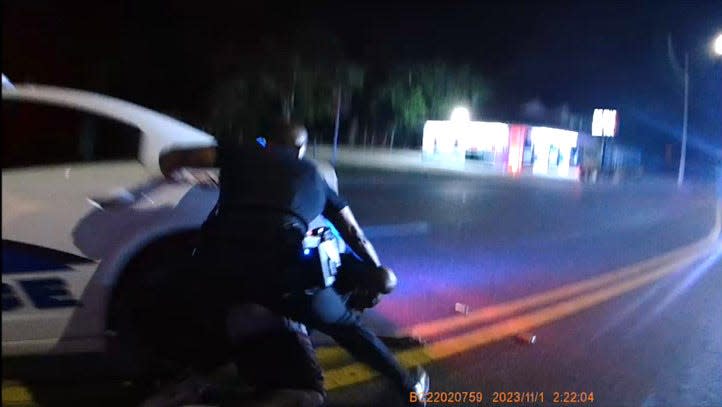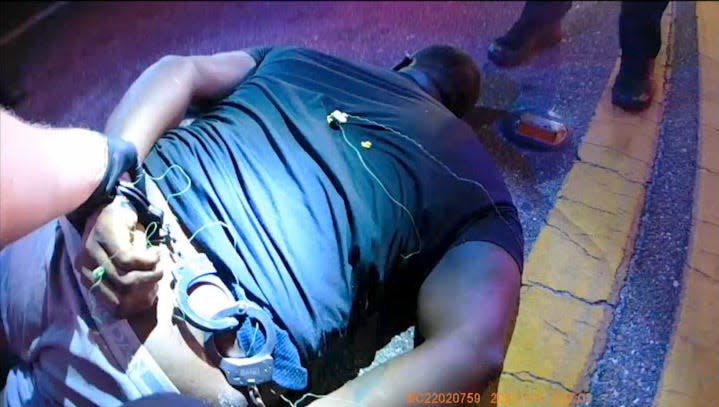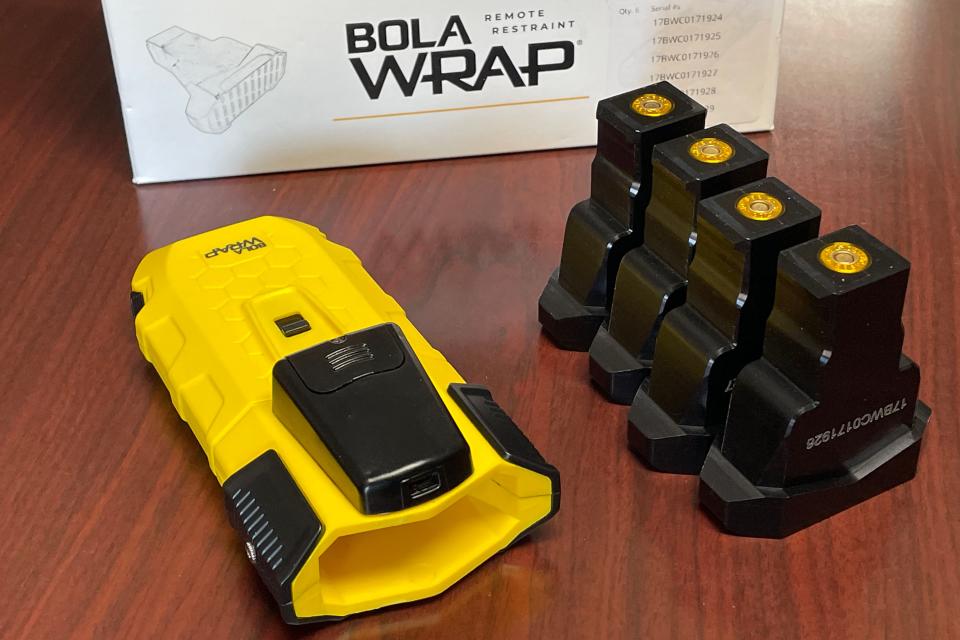Criminal justice, police experts weigh in on Palmetto Police use of force in tasing death
Although state law enforcement officials have cleared local police officers of criminal wrongdoing in the tasing death of Breonte Johnson-Davis, criminal justice experts who reviewed police camera footage say police were too aggressive in their efforts to subdue the man and that officers lacked adequate training, the Herald-Tribune has learned.
Among recommendations national and state experts suggest for local law enforcement are highly-trained mental health personnel and new nonlethal weapons that other departments in the state have begun to use.
The Herald-Tribune provided copies of police camera footage from the November tasing incident to highly-regarded experts in criminal justice research for their opinions regarding how police responded that evening. The November death of the Palmetto man has sparked renewed scrutiny of police practices, particularly concerning the use of Tasers.
A Herald-Tribune investigation in January found that Palmetto PD deploys a Taser nearly as often as any other lethal or non-lethal weapon during use-of-force situations.
Though the Florida Department of Law Enforcement (FDLE) absolved the involved officers of any criminal liability in the death of Davis, questions have been raised by community members and family about the appropriateness of taser deployment in such encounters involving unarmed individuals with behavioral health or substance abuse issues.
More: FDLE investigation finds no wrongdoing in Taser use, death of Breonte Johnson-Davis

Incidents like the one between Johnson-Davis and Palmetto Police underscore frequent calls from around the country for enhanced training to ensure officers are adequately prepared to handle high-stress situations without resorting to potentially lethal force, critics and experts say.
Dennis Kenney, a professor at the New York-based John Jay College of Criminal Justice and former Florida police officer, discussed the Johnson-Davis tasing incident in an interview with the Herald-Tribune, adding context to the situations officers and victims encounter too often.
“I would say the police and the medical authorities were wrong and not notifying the family right away. So waiting until he, I think he said 10 hours or something like that until he died. That was, obviously I have no idea why it took that long, but that shouldn't have taken that long. They should have notified the family that he was he was there.”
“A lot of times, family knows that the person has a problem, that they have an addiction or are mentally struggling. But in the same way that the police have limited choices available to them, the family does as well,” Kenney said.
A medical examiner's report confirmed that Johnson-Davis had methamphetamines in his system during his encounter with Palmetto PD. His mother said in an interview with the Herald-Tribune in early March that her son had been struggling with addiction in recent years.
More: Palmetto mother, activist Tracey Washington dissatisfied with FDLE investigation
“His family may well have known that he was struggling and that he was having difficulty, but what are the options for her to be able to intercede? So, when we're going to look at policy and dealing with mental health crises, we need to look not just at the point where the police are dealing with it, but where everyone else is dealing with it beforehand in the same way that the police have limited choices in the middle range for force. Families frequently have limited choices in the series of events leading up to that encounter, and so we need to expand the range of options in both situations.”
After reviewing the body cam footage provided by Palmetto PD, Kenney said that the encounter between Johnson-Davis and Palmetto PD could be labeled as one with a middle-range use of force. Based on the body cam footage, he said its an example of how police are often ill-equipped and ill-prepared.

“He appeared anxious, he appeared disturbed, he appeared not in full control of himself, which is problematic for the police because they have limited tools. The ability to talk somebody down in that condition is pretty slim,” Kenney said.
For the past 50 years, Kenney has studied and trained in multiple areas of the policing and criminal justice industries. As discussions on police reform continue, the incident has become another focal point for families and advocates pushing for systemic changes in law enforcement training and practices. Kenney says sufficient training is a task in itself for most law enforcement agencies, though.
“It's very difficult for a small department to take an officer or multiple officers off the road for an extended period of time. Generally, they give them a couple of hours in training in talking somebody down, which really is almost the same as no training,” Kenney said.

Palmetto Police Department's response to resistance in tasing death of Breonte Johnson-Davis
Body cam footage provided by Palmetto PD to the Herald-Tribune shows Johnson-Davis appearing incoherent and thrashing on the hood of Officer Caleb Cottom’s patrol vehicle. Not long after, off-duty Bradenton Police Officer Julian Jackson subdued Davis by tackling him to the ground. Corporal Matthew Wilson observed the altercation before deploying his Taser two times into Johnson-Davis. He was then restrained in handcuffs and propped up into the recovery position until Manatee County EMT arrived on the scene.

Palmetto PD Chief Scott Tyler contends that the use of force was within reason.
“I find it reasonable; it’s in our policy... it was to get him handcuffed and get him medical attention,” Tyler told the Herald-Tribune last week.
Tyler confirmed that officers in the Palmetto Police Department undergo Crisis Intervention Team (CIT) training and that the agency partners with behavioral health professionals from Centerstone Behavioral Health when possible. However, he echoed experts, noting that the training is minimal and typically provided when officers enter the police academy.
“There’s nothing anybody can do to help this man until he is restrained... Everyone is horrified by what happened, but it does change the fact that we have to restrain him. It was evident in the way he was reacting that we have to restrain him before it gets to the next level,” he said.
Palmetto police have been equipped with Tasers as non-lethal weapons since 2008.
According to Tyler, officers have had "a whole bunch of Taser deployments" to subdue people in custody and added that there had not been an injury or medical reaction involving a Taser before Johnson-Davis died in custody. In 2023, PPD deployed a Taser on a subject 12 times, the Herald-Tribune reported in January.
Tyler reiterated that the four Palmetto officers involved in the incident used force in accordance with department policy.
Bradenton Police are no longer investigating the incident, according to a public information officer who refused to provide any additional information when questioned by the newspaper.
Alternative options for officers
The 'cracks in the system' can lead to deaths in custody, experts say, but new alternatives can save lives.
Terry Nichols is a retired Texas police chief and advocate for non-lethal law enforcement tools. Nichols pointed to a 2017 Reuters investigation that documented 1,005 incidents in the United States in which people died after police stunned them with Tasers, nearly all since the early 2000s – the most thorough accounting to date of fatal encounters involving the paralyzing stun guns.
“Everything we give an officer that goes on the belt is designed to put pain into the body. Just by design, whether it be a baton, pepper spray, a Taser, or a firearm. All the above are designed for pain compliance,” Nichols explained.
“We can give officers alternatives that do not inflict pain. It's just getting people to understand this, and they just don't want to... and they don't understand the urgency and why society is expecting something different from us as a profession.” Another pulled quote contender
Nichols worked to enact change within his last agency in Seguin, Texas — a suburb of San Antonio with a population of 30,000, roughly double the size of Palmetto — in the wake of the 2020 murder of George Floyd in Minnesota. He instituted a body-worn camera program for officers at the Seguin Police Department and implemented the city's first full-time mental health officer position. He advocated for a non-lethal compliance tool known as a BolaWrap, a deployable and painless Kevlar cord that wraps around a person’s arms or legs.

A handful of Florida law enforcement agencies, the DeFuniak Springs, Hillsborough County Sheriff’s Department, Pembroke Pines, and the Oviedo Police, have added the equipment to their departments.
“We have to embrace it as a profession. Not just the BolaWrap and tool alternatives, that's part of it, but just recognizing these situations ahead of time," Nichols said. "When you see someone in behavioral health or substance abuse crisis, or even at a level of agitation that can escalate, we have to be training the officers, yes in de-escalation tactics but it's also equipping them. All they have is what they have, and that's what we've had for years,” Nichols said.
“Society is looking at us and they expect more out of us now. When your community sees the alternative technology is out there and the training is out there, these chiefs and agencies are going to have to answer some hard questions.”
This article originally appeared on Sarasota Herald-Tribune: Palmetto Police too aggressive, lacked training in Johnson-Davis death

